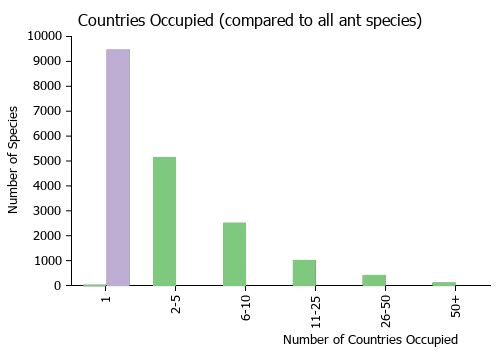Teratomyrmex greavesi
| Teratomyrmex greavesi | |
|---|---|

| |
| Scientific classification | |
| Kingdom: | Animalia |
| Phylum: | Arthropoda |
| Class: | Insecta |
| Order: | Hymenoptera |
| Family: | Formicidae |
| Subfamily: | Formicinae |
| Tribe: | Melophorini |
| Genus: | Teratomyrmex |
| Species: | T. greavesi |
| Binomial name | |
| Teratomyrmex greavesi McAreavey, 1957 | |
Teratomyrmex greavesi is found in a restricted area of extreme south-east Queensland with a single record just across the border in New South Wales. The majority of collections are from rainforest with a single reported as being from dry sclerophyll. Foraging seems to be largely on low vegetation while nests occur in rotten wood on the ground.
Identification
Pronotum very broad and high with large, wing-like projections laterally. Colour uniform throughout body; head narrower (CI < 97 vs. CI > 99 in Teratomyrmex tinae) and scape relatively longer (SI > 106 vs. SI < 98 in T. tinae). These characters easily separate T. greavesi from Teratomyrmex substrictus and T. tinae and this species is unlikely to be confused with them.
Keys including this Species
Distribution
southeast Queensland, northeastern New South Wales
Latitudinal Distribution Pattern
Latitudinal Range: -20.578928° to -28.60888°.
| North Temperate |
North Subtropical |
Tropical | South Subtropical |
South Temperate |
- Source: AntMaps
Distribution based on Regional Taxon Lists
Australasian Region: Australia (type locality).
Distribution based on AntMaps
Distribution based on AntWeb specimens
Check data from AntWeb
Countries Occupied
| Number of countries occupied by this species based on AntWiki Regional Taxon Lists. In general, fewer countries occupied indicates a narrower range, while more countries indicates a more widespread species. |

|
Estimated Abundance
| Relative abundance based on number of AntMaps records per species (this species within the purple bar). Fewer records (to the left) indicates a less abundant/encountered species while more records (to the right) indicates more abundant/encountered species. |

|
Biology
Castes
Images from AntWeb
   
| |
| Worker. Specimen code casent0178515. Photographer April Nobile, uploaded by California Academy of Sciences. | Owned by MCZ, Cambridge, MA, USA. |
Nomenclature
The following information is derived from Barry Bolton's Online Catalogue of the Ants of the World.
- greavesi. Teratomyrmex greavesi McAreavey, 1957: 55, figs. 1-3 (w.) AUSTRALIA. Wheeler, G.C. & Wheeler, J. 1974e: 39 (l.). See also Shattuck & O'Reilly, 2013: 296.
Type Material
- Holotype, worker, Blackall Range, Queensland, Australia, Museum Victoria, Melbourne.
- Paratype, 5 workers, Blackall Range, Queensland, Australia, Australian National Insect Collection.
- Paratype, 1 worker, Blackall Range, Queensland, Australia, Museum of Comparative Zoology.
Unless otherwise noted the text for the remainder of this section is reported from the publication that includes the original description.
Description
Worker
Shattuck and O'Reilly (2013) - (n=10)—CI 91–94; HL 0.71–0.90 mm; HW 0.66–0.85 mm; ML 0.95–1.31 mm; MTL 0.57–0.80 mm; PronW 0.61–0.80; SI 109–118; SL 0.72–0.96 mm.
Body uniform dark brown to almost black. Entire body covered in scattered long setae. Dense, adpressed pubescence on head, mesosoma, gaster and coxae. Head roughly square with convex sides, widest at eyes and tapering slightly inwards posteriorly and more sharply anteriorly. Mandibles small, with six teeth (not five, as reported in the original description), the first, second and fourth the longest. Clypeus triangular with slight central carina, the anterior margin straight laterally with a weak central angle. Frontal area smooth. Frontal carinae short, without ridges. Eyes large, convex, positioned one-third from posterior margin of head, one and a half times longer than wide. Ocelli very small but distinct. Scapes extending one third their length past posterior margin of the head. Mesosoma smooth. Pronotum wider than the rest of the mesosoma, with large winglike projections projecting laterally, the upper surface of these projections with small foveate depressions. Sides of pronotum convex, widest one third posteriorly from pronotal humeri. Promesonotal suture distinct, concave and roughly square. Mesonotum much narrower than the rest of the mesosoma, tapering inwards anteriorly to a narrow constriction. Propodeum narrow, twice as long as wide, but wider than maximum width of mesonotum, expanded dorsally with two small, almost vertical spines. Rear face of propodeum concave and smooth. Petiole narrow and tall, narrowed to a sharp angle dorsally which is concave with two very small spines at each tip. Gaster simple. Legs slender and straight.
References
- McAreavey, J. 1957. Revision of the genus Stigmacros Forel. Mem. Natl. Mus. Vic. 21: 7-64 (page 55, figs. 1-3 worker described)
- Shattuck, S.O. & O'Reilly, A.J. 2013. Revision of the Australian endemic ant genera Pseudonotoncus and Teratomyrmex (Hymenoptera: Formicidae: Formicinae). Zootaxa 3669, 287–301.
- Wheeler, G. C.; Wheeler, J. 1974e. Supplementary studies on ant larvae: Teratomyrmex. Psyche (Camb.) 81: 38-41. (page 39, larva described)
References based on Global Ant Biodiversity Informatics
- Shattuck S. O., and A. J. O'Reilly. 2013. Revision of the Australian endemic ant genera Pseudonotoncus and Teratomyrmex (Hymenoptera: Formicidae: Formicinae). Zootaxa 3669 (3): 287301.
- Taylor R. W. 1992. Nomenclature and distribution of some Australian and New Guinean ants of the subfamily Formicinae (Hymenoptera: Formicidae). Journal of the Australian Entomological Society 31: 57-69.

